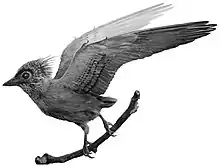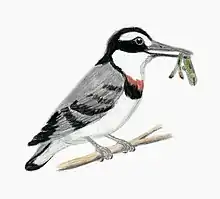| Intiornis Temporal range: Campanian ~ | |
|---|---|
 | |
| The holotype partial hind limb of Intiornis | |
| Scientific classification | |
| Domain: | Eukaryota |
| Kingdom: | Animalia |
| Phylum: | Chordata |
| Clade: | Dinosauria |
| Clade: | Saurischia |
| Clade: | Theropoda |
| Clade: | Avialae |
| Clade: | †Enantiornithes |
| Family: | †Avisauridae |
| Genus: | †Intiornis Novas et al. 2010 |
| Species: | †I. inexpectatus |
| Binomial name | |
| †Intiornis inexpectatus Novas et al. 2010 | |
Intiornis (meaning "Inti bird", the binominal naming means "Unexpected Sun bird"[1]) is an extinct genus of avisaurid enantiornithean birds which existed in what is now North-West Argentina during the late Cretaceous period (Campanian age).[2]
Description
The genus is known from a partial hind limb found in beds of the Upper Cretaceous Las Curtiembres Formation. Three primary toes on a limb of Intiornis are nearly the same length.[1] It was named by Fernando Emilio Novas, Federico Lisandro Agnolín and Carlos Agustín Scanferla in 2010, and the type species is Intiornis inexpectatus. With the body length of around 15 cm (5.9 in)[1] Intiornis was the size of a sparrow, thus representing the smallest enantiornithes known from South America. Its closest relative was Soroavisaurus from the Lecho Formation (Maastrichtian age) of northwestern Argentina.[2]
Phylogeny
The cladogram below is from Wang et al., 2022:[3]
| Enantiornithes |
| |||||||||||||||||||||||||||||||||||||||||||||||||||||||||||||||||||||||||||||||||||||||||||||||||||||||||||||||||||||||||||||||||||||||||||||||||||||||||||||||||||||||||||||||||||||||||||||||||||||||||||||||||||||||||||||||||||||||||||||||||||||||||||||||
| l |
Key to letters:
b = Boluochia
c = Cathayornis
e = Enantiophoenix
f = Houornis
h = Longipteryx
i = Parabohaiornis
j = Pterygornis
l = Vorona
m = Yuanjiawaornis
n = Yungavolucris
Paleobiology
Long toes of equal length and large curved claws suggest adaptability for perching.[1]
References
- 1 2 3 4 Matthew P. Martyniuk (2012). A Field Guide to Mesozoic Birds and Other Winged Dinosaurs. Pan Aves. p. 142. ISBN 9780988596504. Retrieved 29 August 2022.
- 1 2 Fernando Emilio Novas; Federico Lisandro Agnolín; Carlos Agustín Scanferla (2010). "New enantiornithine bird (Aves, Ornithothoraces) from the Late Cretaceous of NW Argentina". Comptes Rendus Palevol. 9 (8): 499–503. doi:10.1016/j.crpv.2010.09.005. hdl:11336/60953.
- ↑ Wang, Xuri; Cau, Andrea; Luo, Xiaoling; Kundrát, Martin; Wu, Wensheng; Ju, Shubin; Guo, Zhen; Liu, Yichuan; Ji, Qiang (2022-02-11). "A new bohaiornithid-like bird from the Lower Cretaceous of China fills a gap in enantiornithine disparity" (PDF). Journal of Paleontology. 96 (4): 961–976. doi:10.1017/jpa.2022.12. ISSN 0022-3360. S2CID 247432530.
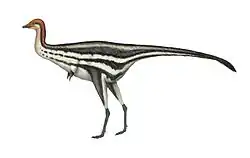
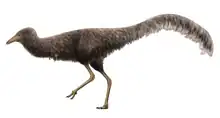



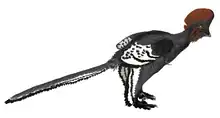


.png.webp)

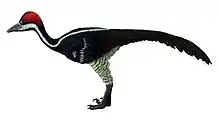
.jpg.webp)
